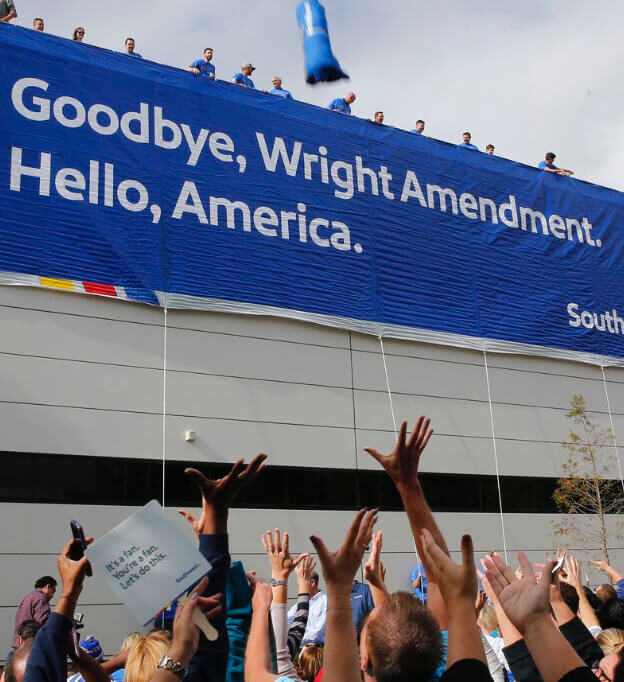
Southwest Employees celebrate outside Headquarters on October 13, 2014.
The Wright Amendment Flies Away
At 12:01 a.m. on October 13, 2014, the countdown clock in the lobby of the Southwest Headquarters building reached zero. For the past year, it had quietly ticked away the minutes and seconds until the Wright Amendment met its end. Shortly after the clock hit zero, Southwest Flight 1013 took off from Dallas, headed for Denver. It was the Company’s first regularly scheduled nonstop service from Love Field outside the boundaries of the Wright Amendment’s restrictions.
The road to repealing Wright was a long one. For decades, Southwest had remained “passionately neutral” about the Wright Amendment, focused on expanding its routes from cities that weren’t bound by the law’s service restrictions. Several states had already successfully lobbied Congress over the years to be added to the restricted list of states Southwest could fly to directly from Love Field, including Mississippi, Alabama, Kansas, and Missouri. However, operations under the Wright Amendment were like running an airline within an airline: one schedule for Love Field, and another for the rest of the United States. By the early 2000s, Southwest Customer traffic in Dallas had been in a steady decline, dropping from 7.1 million passengers in 1996 to 5.4 million in 2003.
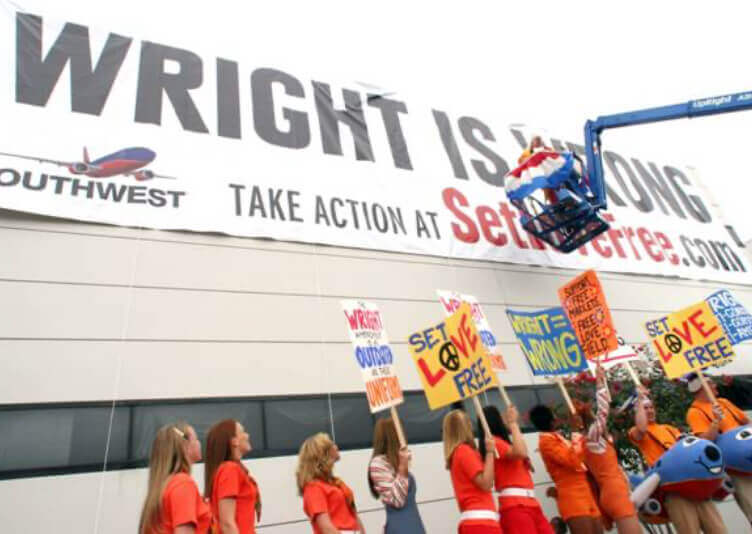
In 2005, Southwest Employees embarked on a grassroots campaign to “Set Love Free.”
“The choice was very simple,” said Chairman and CEO Gary Kelly, who was also President at the time. “Continue to see Love Field and our Dallas presence go into decline, or do something.”
Southwest went all in. In 2004, Gary addressed the North Dallas Chamber of Commerce, announcing the airline’s intent to fight for a repeal of the Wright Amendment. Southwest would no longer be passionately neutral about Wright. It would be passionately committed to bringing about the end of a law that was hampering its growth. Between 2004 and October 13, 2006, the day President George W. Bush signed the law that would gradually bring most of the Wright Amendment to an end, Southwest pursued the largest grassroots campaign in its history. Employees, Customers, and supporters rallied around the charge to “Set Love Free” and get out the message: “Wright Is Wrong.” Lawmakers and other leaders were inundated with phone calls, petitions, and personal appeals.
Between 2004 and October 13, 2006, the day President George W. Bush signed the law that would gradually bring most of the Wright Amendment to an end, Southwest pursued the largest grassroots campaign in its history. Employees, Customers, and supporters rallied around the charge to “Set Love Free” and get out the message: “Wright Is Wrong.” Lawmakers and other leaders were inundated with phone calls, petitions, and personal appeals.
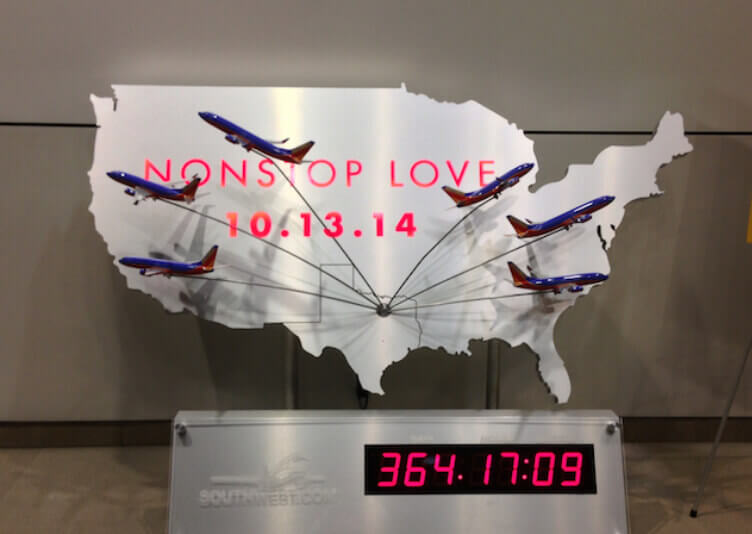
A clock in Southwest’s lobby counts down the days, hours, minutes, and seconds until the sunset on the Wright Amendment is complete.
In May 2005, Southwest designated a “Set Love Free” week that included a Wright Amendment-themed gate-decorating contest, gate games, inflight announcements, and “Set Love Free” fortune cookies on flights. Employees shared “Wright Is Wrong” information cards and encouraged Customers to join the cause by signing petitions. By October 2005, more than 250,000 people in Texas had either signed a petition or written Congress in support of the repeal.
But broad support for the repeal was no guarantee of success. In May 2005, Reps. Jeb Hensarling and Sam Johnson of Texas had introduced H.R. 2646, the Right to Fly Act, to completely repeal the Wright Amendment. If the bill had passed, enacting the repeal might have taken months or even years.
Amid the lobbying, negotiations In the end, Southwest agreed to a compromise that would guarantee the end of Wright over time rather than risk a wait-and-see approach in Congress that may or may not have ended favorably. The compromise led to the Wright Amendment Reform Act, H.R. 5830, which landed on President Bush’s desk in 2006. The Five Party Agreement, as it came to be known, wasn’t instant. It dictated a “sunset” to the Wright Amendment over eight years that would give DFW and other airlines time to prepare for the change.
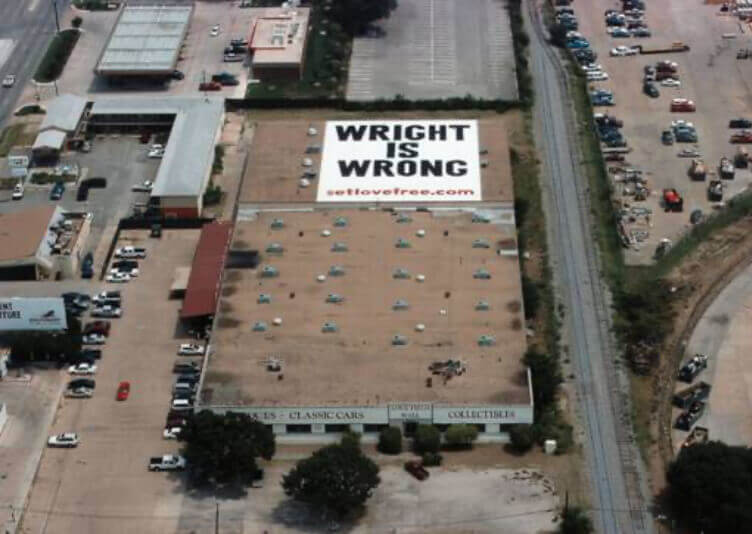
Local businesses stepped up to support Southwest’s campaign to end the Wright Amendment, from the ground and the air.
In the phased approach, Southwest would immediately be able to schedule flights from Love Field to cities anywhere in the United States, provided they made at least one stop in a Wright zone city. In 2014, the Wright Amendment would effectively end, allowing Southwest to fly nonstop to any domestic destination.
There was no longer any question: Wright was on its way out. It was just going to take a little longer than Southwest had hoped for. “Did we want the Wright Amendment to live on for eight more years? Heck, no,” then-President Colleen Barrett said when the repeal passed. “Can we make this new arrangement work and continue to grow and prosper? Heck, yes!”
As the countdown to October 13, 2014, drew near, excitement grew. If ever there was a reason to celebrate, it was the end of the Wright era. The Sunday before the Wright Amendment’s official sunset, the Company turned Klyde Warren Park in downtown Dallas into its celebration headquarters with concerts and fireworks. And on October 13, with Southwest finally out from under the restrictions of the Wright Amendment, more than 9,000 attendees—Employees and their guests—traveled to Dallas for a Spirit Party, literally partying the Wright away.
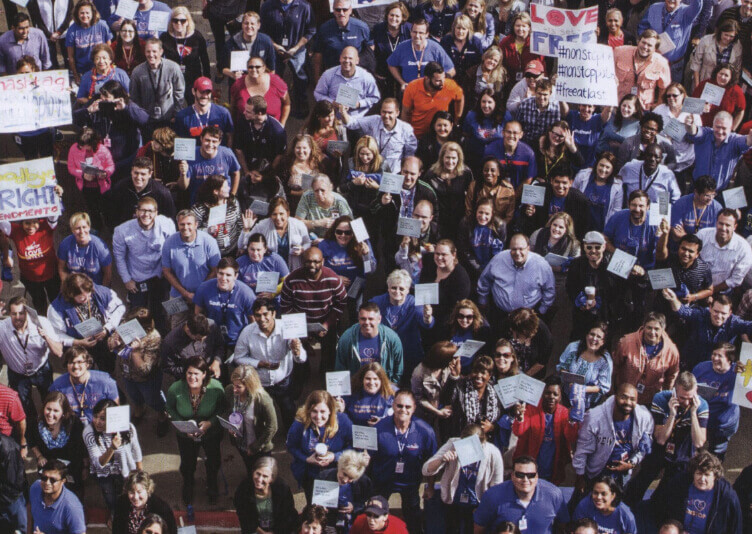
Employees gather at Southwest’s Dallas Headquarters to celebrate freedom from the Wright restrictions.
